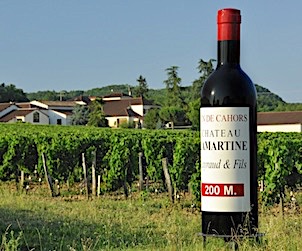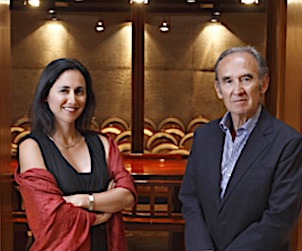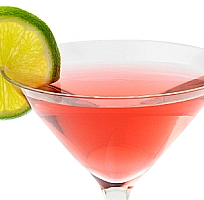Well Guthrie is a frontrunner of a new wave of winemakers who are turning away from the ripe, highly extracted wines that have become a trademark of Californian Pinot Noirs. As a tasting co-ordinator at the Wine Spectator in San Francisco, Guthrie found himself increasingly oriented to the more restrained, Rhone style wines. To pursue this, he set out in his late twenties to apprentice for two years under the famed Marc Chapoutier in France’s Northern Rhone, studying biodynamic winemaking techniques.
But when Guthrie returned to California penniless at the age of thirty, he ended up working for Helen Turley who was squarely in the camp of making highly extracted fruit bombs, the kind that Robert Parker Jr. endorsed. In 1999, Guthrie co-founded Copain Wine Cellars in Sonoma’s Russian River Valley with his software designer pal Kevin McQuown. They called it “Copain” (French for ‘buddy”) in honour of their friendship. Their first year production was small at only 500 cases, and so they quickly ran out of their robust Syrah made from grapes grown across California after it won accolades from Parker.
In 2006, Guthrie did an about face. Frustrated by the high alcohol levels of his intense reds, he began a transition in 2007 to minimalist intervention and earlier harvesting to make Rhone-style wines with finesse over power. His 2008 production had to be declassified because of the smoke taint from nearby rampant forest fires. But an early harvest ahead of the rainy season in 2009 enabled him to create a vintage that was exceptional in showcasing his new style.
Guthrie’s focus is on attaining ripe fruit without high alcohol, showing a style of restraint that delivers elegant, Burgundian style wines. He sources fruit primarily from the Anderson Valley of Mendocino County. It is the coolest climate region in California, influenced by the Pacific Ocean breezes, just 10-15 miles away. He builds close relationships with growers who endorse clonal selections and organic farming practices. Guthrie believes that higher sugar content in the grapes, and therefore higher alcohol in a wine, is achieved at the expense of low acidity. His goal is therefore to keep alcohol levels below 13.5%, which is about 1% less than what he believes the average to be in California these days.
Production increased from 16,000 cases in 2009 to 20,000 cases in 2010 and his target is 25,000, which means Copain will continue to be a boutique winery. Its varietal mix is currently 60% Pinot Noir, 37% Syrah and 3% Chardonnay. Pinot Noir will eventually be reduced to 50%. Copain makes three tiers of wine, following the Burgundian model of Appellation, Village and Gran Cru wines. Copain’s equivalent tiers are its Tous Ensemble, Les Voisins and Single Vineyard wines (from five vineyards).
Tony McClung, Copain’s General Manager led a tasting at agent Barrel Select’s offices in Toronto recently. Here are my notes.
Copain Chardonnay “Tous Ensemble” 2010 (13.8%; $37.10) is an Anderson Valley wine that was stainless steel fermented. Pale lemon in colour, it shows fresh fruit flavours of lemon and pears and has a flinty aspect, with a good acidic structure and an elegant finish.
![]()
Copain Pinot Noir “Tous Ensemble” 2010 (13.4%; $35.46) was made in a cool vintage that can be difficult in California, but which was ideally suited to Burgundian cool climate grapes. Guthrie took the ‘spice rack’ approach by blending grapes from seven different vineyards in the Alexander Valley. Garnet coloured, it offers cherry, cranberry and red berry fruit flavours, with a subtle beet root and earthy undertone. ![]()
Copain Pinot Noir “Les Voisins” 2009 (13.3%; $59.45) is made from grapes sourced from three neighbouring vineyards at the western ‘deep end’ of Anderson Valley. Just a few miles from the Pacific Ocean, this is the coolest area of the valley. ‘Sunspots’ provide extra sun and warmth, causing temperature swings of five degrees that give a cooling effect in what was a very warm vintage. This deep ruby red, elegant wine has a lush palate of sweet cherries, with cinnamon accents in the moderate finish. ![]()
Copain Pinot Noir Monument Tree Vineyard 2010 (13.6%; $92.62) is from a single vineyard (“Monument”) that Guthrie has been working with since 2001. It was recently bought by the owners of Silver Oak and Twomee wines, who have given Copain a seven year lease. Deep cherry coloured, it has a lush palate with forest berry, red currant and cranberry aromas and flavours, and a good acidic structure. ![]()
Copain Syrah “Tous Ensemble” 2010 (13.6%; $35.23) comes from grapes sourced from five vineyards on the Yorkville Highlands of Mendocino County. Achieving optimal ripeness proved a challenge in this very cool vintage. Since 2007, Guthrie has been phasing out the influence of new oak to produce gentler tannins, eliminating it entirely in this vintage. Deep garnet coloured, this wine has dark cherry flavours with black pepper and tobacco notes. ![]()
Copain Syrah “Les Voisins” 2010 (13.9%; $51.98) is made from three neighbouring hilltop vineyards, ranging in elevation from 1800 (Eagle Point Vineyard) to 2200 (Hawks Butte) and 2600 feet (Halcon Vineyard). Still tight, this wine will improve with three to five years of cellar aging. Deep plum in colour, this aromatic wine has violet aromas, sweet red cherry, cranberry and plum flavours, with subtle cocoa powder, spice and black pepper accents and a lively acidity in the finish. ![]()
Copain Syrah Halcon Vineyard 2010 (13.9%; $72.95) is made from their flagship vineyard, which has granite, decomposing schist and limestone soil. The steepness of the vineyard means the grapes have to be hand harvested. Because there is typically only one grape cluster per vine, the yield is extremely low at one ton per acre. This inky wine has wonderful aromatics and round berry and cranberry flavours.
![]()
All scores are out of five apples.
Barbara D. Ritchie is a wine writer, lecturer and internationally accredited wine judge, who has travelled extensively throughout the main wine growing regions of the world. Her working knowledge of French, Italian, Spanish and German facilitates her in-depth winery profiles. A distinctive aspect to writing is her suggestions for food and wine pairings.







